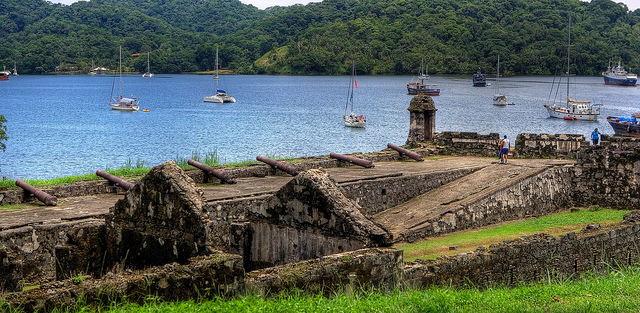Especially for such a tiny country, Panama has quite a bit to offer even beyond the canal and the historic and and also excitingly modern capital Panama City. One particularly cool example is the dreamy stretch of the middle Panama Caribbean coast between Colón and Portobelo, where tropical breezes echo with traces of the Spanish colonial past.
At one end lies the country’s second largest city, Colón (pop. 78,000, metro 242,000), named after Christopher Columbus (Cristóbal Colón in Spanish) and located near the terminus of the Panama Canal. A hive of activity, it’s been renovating itself after years of decline, and its duty-free zone is huge and impressive – the second largest in the world, in fact. Indulge in a bit of shopping at great prices; have a look at several of the local landmarks such as its handsome cathedral; and of course check out the canal’s Gatún Locks, their visitor centre, and observation deck – the sight of titanic ships moving in and out is nearly hypnotic.
From here you’ll also want to take a five-minute speedboat ride out to Isla Grande, an hour along the coast. Out here there’s a laid-back, small-town feel with paradisiacal beaches yet also some hotels, restaurants, and pubs.
Then, just an hour’s drive along the coast from Colón, you arrive at the historic town of Portobelo. The bay here was visited by Columbus in 1502 on his third voyage of exploration, and as the 16th century advanced, a bustling port town grew up here – only to be destroyed by English pirates such as Francis Drake and Henry Morgan, as well as Spanish conflict with Britain (fun fact: as the result of its 1739 capture by the Brits, the town’s name became memorialised throughout the United Kingdom, such as London’s Portobello Road).
Its current incarnation is a shadow of its former self, but some of Portobelo’s local landmarks have been restored, most notably the 1630 Aduana (Customs House, where treasure and merchandise being shipped from Central America to Spain were stored) and the Church of San Felipe, whose most priceless possession is a statue of the Black Christ, attired in velvet and kept in a glass enclosure; it has a nationwide following and is the centrepiece of one of the town’s biggest celebration, every October 21st. Otherwise, here it’s all about getting a glimpse of small-town Panamanian life – kids playing, neighbours gossipping, and teenagers cruising around in cars with the music turned up.
We’re not done with Portobelo yet. Right nearby is a fortress complex dating back to the 17th and 18th centuries, built to defend Spain’s aforementioned transatlantic shipping. With cannons pointed seaward, their doughty stone strongholds are reminiscent of those back in the mother-country city of Cádiz, also the model for various other coastal fortifications throughout Latin America.
From here you can also get an eyeful of the area’s exuberant local nature. If you want to experience it more close up, head a bit inland inland from Portobelo to the rain-forested Chagres National Park, whose Chagres River, Alajuela Lake, and other waterways are ideal for all manner of aquatic pursuits including swimming, rafting, waterskiing, Jet-Skiing, and boating (the lake in fact frequently hosts competitions). Local tour operators will also take you on excursion in part of its 1,290 square kilometres (498 sq. miles) to experience its flora, fauna, and Amerindian villages.
The best time of year to visit Panama is January through April.
More information: ColonCity.com.

Comments